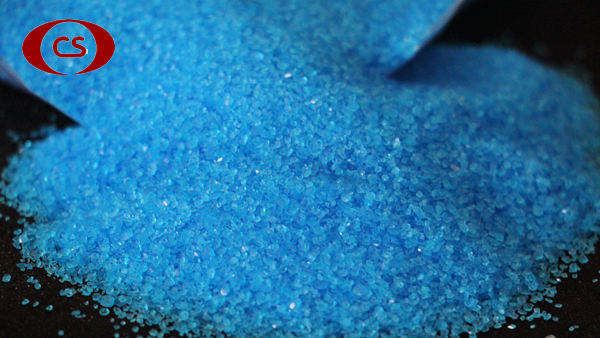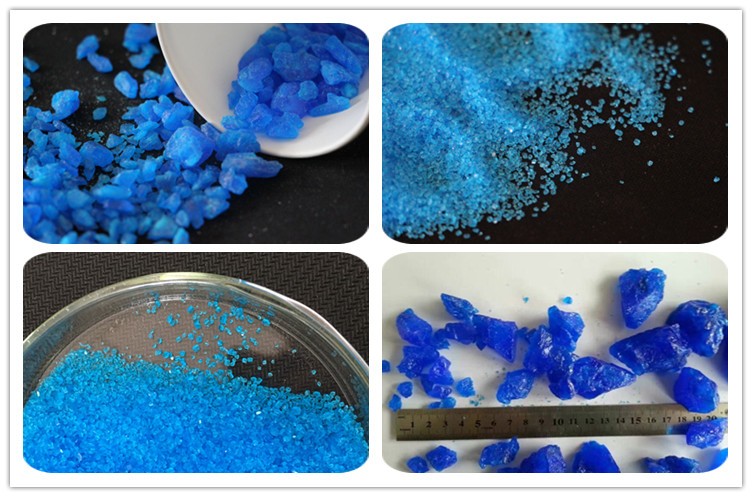The fish pond is full of ripples and the fish are swimming happily, creating a lively scene. However, there is a hidden crisis under the calm water. The shadow of disease may cover the entire farm at any time, causing huge economic losses to farmers. At this time, an inconspicuous blue crystal, copper sulfate, came into people’s view. It is like a double-edged sword. While protecting the health of aquaculture, it also hides huge risks. This article will deeply analyze the application of copper sulfate in aquaculture, revealing the delicate balance between its efficacy and risks, and provide farmers with a scientific and safe medication guide.
1. The sharpness of blue crystals: the bactericidal mechanism of copper sulfate
Copper sulfate, with the chemical formula CuSO₄·5H₂O, commonly known as blue vitriol, has a bactericidal mechanism mainly derived from the biological activity of copper ions (Cu²⁺). Copper ions can bind to proteins in pathogen cells, destroy their enzyme activity, and thus inhibit the growth and reproduction of pathogens. This mechanism of action is particularly effective for lower organisms such as unicellular algae and protozoa. For example, common fish parasites such as wheelworms and oblique tubeworms, as well as algae such as blue-green algae and water web algae that cause water quality deterioration, are all sensitive to copper ions.
However, the bactericidal effect of copper sulfate is not equally effective for all pathogens. For example, the therapeutic effect on bacterial diseases is relatively weak, and it is almost ineffective for some viral diseases. In addition, copper sulfate is also toxic to fish themselves, so accurate medication is essential. Excessive use or improper operation will not only fail to achieve the expected effect, but will cause fish poisoning or even death, and pollute the water environment.
2. Precision application: the art of concentration, timing and method
The application of copper sulfate is not simply “the more the better”. There is a narrow range between its effective concentration and safe concentration, and a slight mistake can cause serious consequences. There are many factors that affect the efficacy and toxicity of copper sulfate, including:
Water temperature: The higher the water temperature, the greater the toxicity of copper sulfate and the lower the safe concentration. Under high temperature, the metabolism of fish is accelerated and their sensitivity to poisons is enhanced.
pH value: In an alkaline environment, copper ions are prone to form copper hydroxide precipitation, which reduces the effective concentration and thus reduces the bactericidal effect. Acidic environments will increase the toxicity of copper ions.
Organic matter content in water bodies: Organic matter will combine with copper ions, reduce their effective concentration, and thus affect the bactericidal effect. In water bodies with high organic matter content, the safe concentration of copper sulfate is relatively high.
Fish species and size: Different fish have different tolerances to copper sulfate, and young fish are more sensitive to copper sulfate than adult fish.
Therefore, in practical applications, it is necessary to accurately calculate the dosage and select the appropriate application method according to the specific situation. For example, for preventive medication, a low concentration can be used for full-pond spraying, controlled below 0.5ppm. For therapeutic medication, it is necessary to select the appropriate concentration and application method according to the severity of the disease, such as immersion therapy or topical medication. Immersion therapy requires strict control of time and concentration to avoid excessive exposure of fish to high-concentration solutions. Topical medication can reduce pollution to the entire water body and improve treatment efficiency.
3. Synergistic effect of copper sulfate and other drugs
In practical applications, copper sulfate is often used in combination with other drugs to enhance efficacy or reduce toxicity. For example, the combination of copper sulfate and ferrous sulfate can effectively prevent and treat some parasitic and bacterial diseases. Ferrous sulfate can assist in sterilization and regulate water quality, while reducing the toxicity of copper sulfate. However, combined medication also requires caution, and a full understanding of the characteristics of various drugs and their interactions is required to avoid adverse reactions.
4. Risks and Prevention: The Duality of Blue Crystals
Although copper sulfate is effective, its potential risks cannot be ignored. Long-term or excessive use of copper sulfate can cause a series of adverse reactions in fish, such as:
Kidney damage: The accumulation of copper ions can cause dilation and necrosis of renal tubules, affecting the excretion function of fish.
Liver damage: The liver is an important detoxification organ of fish. The accumulation of copper ions can damage liver cells and affect the metabolic function of the liver.
Gill tissue damage: Copper ions can damage gill tissue, affect the respiratory function of fish, and cause fish to die of hypoxia.
Growth inhibition: Copper ions can interfere with the digestion and absorption function of fish and affect their growth and development.
Therefore, when using copper sulfate, the dosage must be strictly controlled to avoid long-term or excessive use. At the same time, it is necessary to regularly monitor water quality, observe the growth status of fish, and promptly detect and deal with adverse reactions.
5. Future Outlook: Safer and More Effective Drug Development
Although copper sulfate still plays an important role in aquaculture, its toxicity limits its widespread application. In the future, the development of safer, more efficient and more environmentally friendly aquaculture drugs is an inevitable trend in the development of the industry. This requires researchers to continue to work hard to develop new drugs and treatment technologies to reduce dependence on traditional drugs and achieve sustainable development of the aquaculture industry.
Post time: Apr-11-2025



